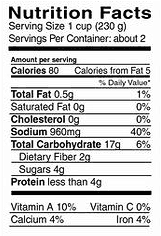17 August 2002
Nutrition Facts Facts
Says @issue: The Journal of Business and Design:
 “Less than a century ago, food labels barely identified what was inside a box. Consumers had to trust the manufacturer to use only healthy ingredients—not always a safe bet. In 1924, the Federal Food and Drug Act gave the U.S. Food and Drug Administration (FDA) authority to clamp down on bogus health claims and misleading labels. The FDA also tried to make manufacturers more accountable by requiring them to list their names and addresses on the packaging. By 1973, packaged food makers were also required to supply nutritional values listing the amount of vitamins and minerals inside, but the manner in which this information was presented was often inconsistent and incomplete. The Nutrition Labeling and Education Act of 1990 finally called for a major overhaul of food labels. The FDA and U.S. Department of Agriculture set out uniform guidelines for the new labels. Launched in 1994, Nutrition Facts offers a plethora of health-relevant information.”
“Less than a century ago, food labels barely identified what was inside a box. Consumers had to trust the manufacturer to use only healthy ingredients—not always a safe bet. In 1924, the Federal Food and Drug Act gave the U.S. Food and Drug Administration (FDA) authority to clamp down on bogus health claims and misleading labels. The FDA also tried to make manufacturers more accountable by requiring them to list their names and addresses on the packaging. By 1973, packaged food makers were also required to supply nutritional values listing the amount of vitamins and minerals inside, but the manner in which this information was presented was often inconsistent and incomplete. The Nutrition Labeling and Education Act of 1990 finally called for a major overhaul of food labels. The FDA and U.S. Department of Agriculture set out uniform guidelines for the new labels. Launched in 1994, Nutrition Facts offers a plethora of health-relevant information.”
Brand design firm Greenfield/Belser, best known for their law firm marketing material, designed the new nutrition facts label. Reknown designer Massimo Vignelli lauded the label design in the July 1996 AIGA Journal. Praising the clarity of the information architecutre, its visual integrity, and flexibility of the design on packages of all shapes and sizes, he writes, “The label is a clean testimonial of  civilization, a statement of social responsibility, and a masterpiece of graphic design. Not a small achievement in today’s graphic landscape.” He does not point out that the generic, anonymous design and apparent lack of “marketing devices” actually brands the space and its information as neutral, scientific, institutional, and authoritative.
civilization, a statement of social responsibility, and a masterpiece of graphic design. Not a small achievement in today’s graphic landscape.” He does not point out that the generic, anonymous design and apparent lack of “marketing devices” actually brands the space and its information as neutral, scientific, institutional, and authoritative.
Greenfield/Belser’s Web site describes other forays into design in the public interest as well:
“In 1999, we applied a variation of that label design, Drug Facts, to all over-the-counter drugs. Years earlier, we designed the Energy Guide that appears on all major appliances.”

